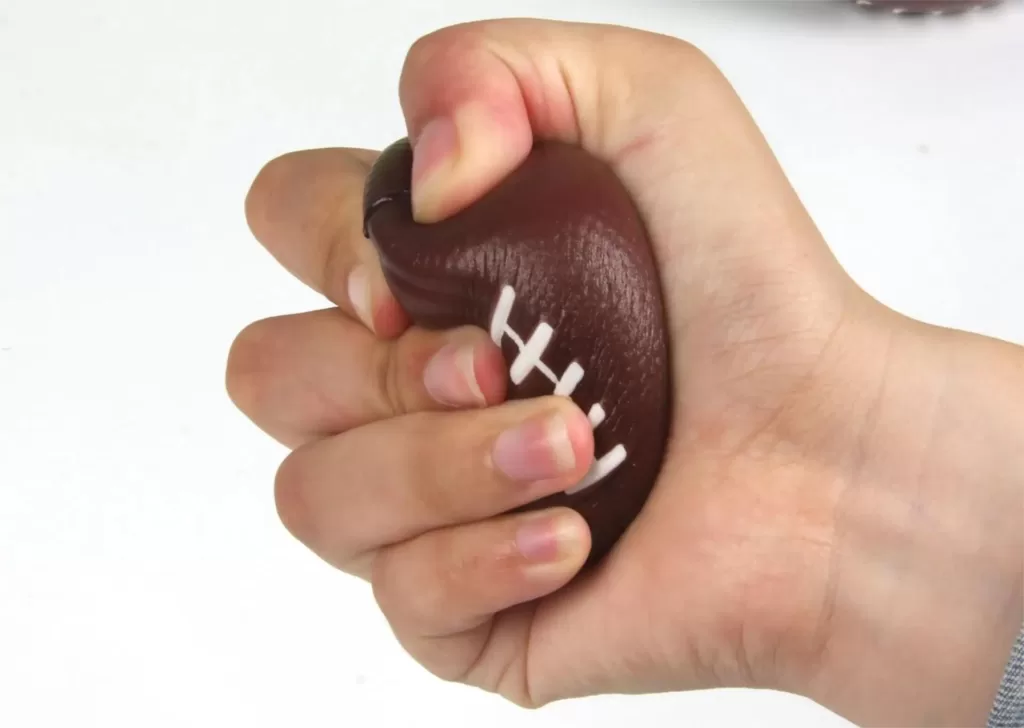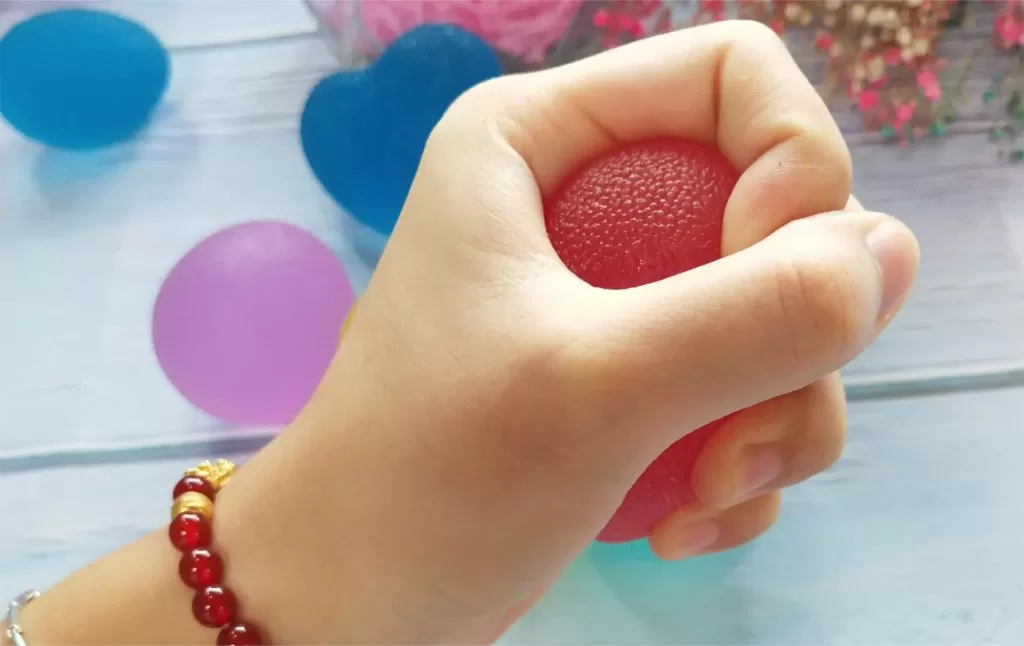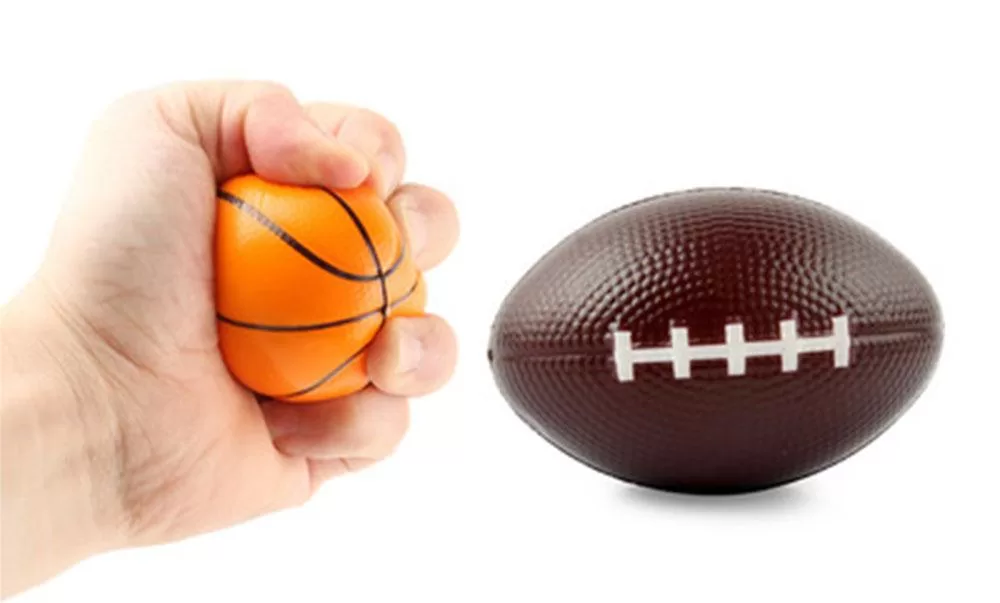Modern people often need to use keyboards, mice, cell phones, and other electronic devices in their daily lives and work, and prolonged use of these devices can easily lead to stiffness and fatigue in the hands. The grip ball was born to solve this problem. It can not only exercise hand muscles and enhance hand strength, but also promote hand blood circulation, relieve hand fatigue and stiffness, and make your hands more flexible. Today, we will recommend polyurethane grip balls for you to have a deeper understanding of polyurethane grip balls.

What is a Polyurethane Grip Ball?
Polyurethane grip balls are handheld exercise equipment made of polyurethane material that is durable, non-slip, waterproof, and abrasion-resistant. Grip balls are usually spherical in shape and vary in size and weight, allowing you to choose the right size and weight for your individual fitness level and goals. Useful training equipment for athletes engaged in activities that require hand strength and control, such as wrestling, martial arts, mountain climbing, and fencing.
What is the Function of a Polyurethane Grip Ball?
The main function of the polyurethane grip ball is to enhance the strength and flexibility of the hand muscles while improving hand coordination and fine motor skills. Its role is mainly reflected in the following aspects:
- Enhance finger and wrist muscle strength: Grip strength ball use requires constant hand grip on the ball, which can exercise the fingers, palm, and wrist muscles. Continuous training can gradually increase the strength of the hand muscles, thus improving the grip and control of the hand.
- Improve hand dexterity: Polyurethane grip strength balls can help strengthen the muscle groups of the fingers, wrists, and palms, thereby enhancing hand dexterity and mobility. This is very important for workers or athletes who need to use their hands frequently.
- Improve hand coordination: Grip ball can help train hand coordination and fine motor skills by controlling the rotation and swing of the ball and other movements, which can improve hand coordination and reaction speed.
- Prevent hand diseases: Insufficient hand muscle strength or improper use can easily cause hand fatigue, muscle spasm, and other problems, the grip ball can help prevent these problems, and improve the stability of the hand and fatigue resistance.
Overall, the polyurethane grip ball is a simple and effective training device for people who need to use their hands frequently, and training with a grip ball can help improve the health and function of the hands.
What are the Types of Polyurethane Grip Balls?
The types of polyurethane grip balls are classified mainly according to the size and weight of the ball, and different types are suitable for different fitness goals and levels.
- Ordinary grip ball: usually spherical, usually between 5-7 cm in diameter, with a weight ranging from 100 grams to 2 kg. This kind of grip ball is suitable for newcomers or people in the early stages of fitness, relatively easy to use.
- Challenge grip ball: This grip ball is usually heavier, larger in diameter, and requires greater strength to hold. The challenge grip ball is suitable for people who have been trained for a certain period of time and can improve hand muscle strength and control ability.
- Irregular grip ball: This grip ball is irregular in shape, such as the oval, or star-shaped, ball surface has a raised and other special design, needs higher control and stability, suitable for training hand fine motor ability and coordination.
- Massage grip ball: This grip ball surface with a raised and depressed design, can help massage hand muscles and acupuncture points, to relax and relieve the hand fatigue effect.
- Double grip ball: This grip ball is designed to be connected to the form of two spheres, requiring two hands to hold the ball at the same time to be able to use it. A double grip ball is suitable for training arm muscle strength and hand coordination.
Of course, in real life, grip balls can be divided into many more categories.
What are the Materials of Common Grip Balls?
There are three main types of grip ball materials commonly available on the market today:
- Polyurethane material: This is the most common grip ball material, polyurethane is a durable, soft material, that can effectively absorb shock and vibration while having good resistance to wear and tear and durability.
- Rubber material: Rubber grip ball compared to polyurethane grip ball, the texture is harder, and feels more elastic. However, rubber grip balls are usually more slippery and require extra grasp force.
- Metal material: A metal grip ball is usually made of iron, stainless steel, copper, and other metals, The weight is heavier, but the surface is often slippery and requires special treatment to increase the grip.
Overall, polyurethane is the most common material for grip balls because it is soft, durable, resistant to wear and tear, shock-absorbing, and does not slide easily, allowing for better exercise of the hand muscles. However, for individuals, different materials may have different effects on the feel and experience of use and need to be chosen according to personal preference and fitness goals.

What is the Difference in Size and Weight of Polyurethane Grip Balls?
The size and weight of polyurethane grip balls can vary, depending on the manufacturer and product model. Typically, polyurethane grip balls range in diameter from 5cm to 8cm and in weight from 100g to 500g.
For beginners, it is recommended to start with lighter weights, such as 100g or 200g, and then gradually increase the weight and training time. For more experienced users, you can choose a heavier polyurethane grip ball, such as 300 grams or 500 grams, to challenge your grip strength and endurance. Of course, if there is any discomfort or pain in the hands, training should be stopped immediately.
The size and weight of a polyurethane grip ball have an effect on its training effectiveness. If you choose a polyurethane grip ball that is too large or too heavy, it may lead to hand fatigue, discomfort, and injury. Therefore, it is very important to choose the right size and weight for the polyurethane grip ball.
How to Use a Polyurethane Grip Ball Correctly?
The following are the steps for the proper use of polyurethane grip balls:
- Choose the right weight and size: Beginners can choose a lighter grip ball, such as 100 grams or 200 grams, to gradually increase the difficulty. More experienced users can choose a heavier polyurethane grip ball, such as 300 grams or 500 grams.
- Hold the polyurethane grip ball: Hold the grip ball in your hand with your fingers straight, then slowly bend your fingers to hold the grip ball tight. When holding the polyurethane grip ball, the palm and fingers should be hard, but do not overexert yourself to avoid hand fatigue and injury.
- Practice grip strength: Hold the grip ball and grip it hard for 5-10 seconds, then release it and let your fingers and palms return to their original shape. Repeat this action 10-15 times, then rest for 1-2 minutes before performing the next set of exercises. The number of exercises and sets can depend on individual needs and purpose.
- Exercise flexibility: Place the grip ball in the center of your palm and use your fingers to squeeze the polyurethane grip ball toward the center of your palm before slowly releasing it. Repeat this movement 10-15 times, then rest for 1-2 minutes before performing the next set of exercises.
- Increase the difficulty: As the hands gradually adapt to the grip ball, you can gradually increase the weight and training time of the grip ball to challenge your grip strength and endurance.
It is important to note that when using polyurethane grip balls, excessive force should be avoided to avoid hand fatigue and injury. If there is any discomfort or pain in the hands, training should be stopped immediately. In addition, proper warm-up and stretching should be performed before and after training to avoid sports injuries.
How Effective is the Training of Polyurethane Grip Balls?
Benefits of Grip Ball Training
Muscle Strengthening: Grip ball exercises fortify the fingers, wrists, and forearm muscles, enhancing their power.
Enhanced Dexterity: These exercises improve hand control, reducing the chances of stiffness and pain.
Endurance Boost: The exercises enhance the stamina of hand muscles, enabling prolonged holding or movement of heavy objects.
Coordination and Circulation
Improved Hand Coordination: Training with grip balls refines hand-muscle coordination, leading to better fine motor skills.
Blood Circulation: The exercises promote hand blood circulation, alleviating muscle fatigue and stiffness.
Therapeutic and Aesthetic Benefits
Pain Relief: Grip ball exercises can alleviate symptoms of certain hand conditions, such as finger arthritis.
Aesthetic Enhancement: Regular exercises can result in more toned and firm hand muscles, improving the overall appearance of the hands.
Remember, grip ball training is only one method of hand strength and flexibility training, it is not a complete substitute for other hand training, such as training for hand grip, pushing and pulling, flexion, and extension movements. At the same time, the training effect will vary depending on the individual’s physical condition, training intensity, and frequency. Therefore, before using the grip ball for training, it is best to consult a doctor or professional trainer for advice, develop a suitable training plan, and pay attention to gradually increasing the intensity of training.

What are the Maintenance and Care Methods for Polyurethane Grip Balls?
Maintenance and care can extend its service life and ensure its training effect and safety. The following are common maintenance and care methods:
- Clean regularly: Use a damp cloth or water to clean the surface of the grip ball, and avoid using cleaners or brushes containing chemicals to avoid damaging the polyurethane surface.
- Avoid collision: Avoid colliding or dropping the grip ball with other hard objects to avoid damaging its surface or internal structure.
- Avoid high temperature: Avoid exposing the grip ball to a high-temperature environment, such as direct sunlight, or a heater, to avoid deformation or loss of elasticity of the polyurethane material.
- Keep dry: store the grip ball in a dry and ventilated place, avoid storing it in a humid environment, so as not to affect its quality and service life.
- Avoid long-time compression: Long-time compression of the grip ball will affect its shape and elasticity, so do not compress it for a long time when storing.
- Replace regularly: If the surface of the grip ball shows obvious wear or deformation, or if it no longer feels good elasticity in the process of use, it should be replaced in time.
The above methods are only the general maintenance of polyurethane grip ball and maintenance methods, specific operation methods should also be based on the material and manufacturer’s instructions for grip ball.
Polyurethane Grip Ball is Suitable for Which People?
Polyurethane grip balls are a fitness tool used to exercise the muscles of the fingers, wrists, and forearms and are suitable for most people, especially those who:
- Office people: Sedentary office people are prone to hand muscle stiffness, the use of grip ball exercise finger and wrist muscles can relieve hand discomfort.
- Musical instrument lovers: playing musical instruments requires hand flexibility and strength, using the grip ball can enhance finger flexibility and muscle strength to improve the playing level.
- Athletes: Polyurethane grip balls are great for athletes who need hand strength and dexterity to play tennis, basketball, weightlifting, etc., and can help them improve hand muscle strength and reaction speed.
- Rehabilitation people: The grip strength ball is also suitable for some people who need rehabilitation, such as finger arthritis, wrist ligament injury, etc., which can help them restore hand muscle strength and flexibility.
It should be noted that some people with hand injuries or diseases, need to first consult a doctor or professional coach for advice and develop a suitable training plan. When performing grip ball exercises, care should be taken to gradually increase the intensity and duration of the exercises to avoid excessive training leading to hand fatigue or injury.
How to Choose the Right Polyurethane Grip Ball for You?
Before choosing the right polyurethane grip ball for you you might want to consider the following:
- Strength level: There are usually different strength levels, such as beginner, intermediate, advanced, etc. You need to choose the right strength level for you according to your hand strength and training needs.
- Size: Size is also an important selection factor, You should choose a grip ball suitable for your hand size, to ensure a comfortable and stable grip, not easy to slide or fall off.
- Material quality: The quality of the material directly affects its service life and training effect, should choose a better quality polyurethane material to ensure its durability and use effect.
- Brand reputation: Choosing a well-known brand of polyurethane grip ball can guarantee its quality and after-sales service, to avoid quality problems leading to training hindrances.
- Training needs: Different training needs require different types of polyurethane grip balls, such as the need to strengthen finger strength people can choose a small, need to strengthen wrist strength people can choose a large.
Overall, choosing the right polyurethane grip ball for you requires comprehensive consideration based on your actual situation and training needs, choosing the right strength level, size, etc. You can read the product description carefully before purchasing, or consult a professional coach or experienced athlete to get better advice and choices.

Conclusion
Polyurethane grip balls are designed to enhance hand flexibility and strength. Regular use can help improve grip, alleviate stress, and aid in rehabilitation after injuries. Made from durable polyurethane, these balls are both long-lasting and comfortable to use. Whether you’re an athlete, musician, or someone looking to improve hand dexterity, polyurethane grip balls offer a simple yet effective solution.

